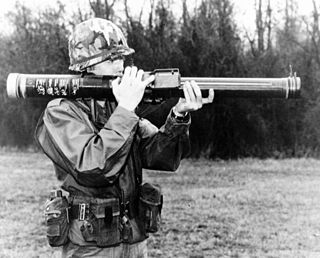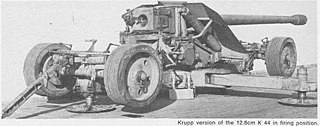
Armour-piercing ammunition (AP) is a type of projectile designed to penetrate armour protection, most often including naval armour, body armour, vehicle armour.

The 8.8 cm KwK 36 was an 88-millimetre (3.5 in) tank gun used by the German Army during World War II. This was the primary armament of the PzKpfw VI Tiger I tank. It was developed and built by Krupp.

The 8.8 cm KwK 43 was an 88 mm 71 calibre length tank gun designed by Krupp and used by the German Wehrmacht during the Second World War. It was mounted as the primary armament on the Panzerkampfwagen VI Ausf. B Tiger II. The 8.8 cm Pak 43, an anti-tank gun, was very similar in design but mounted on tank destroyers or deployed stand-alone on the field.

High-explosive anti-tank (HEAT) is the effect of a shaped charge explosive that uses the Munroe effect to penetrate heavy armor. The warhead functions by having an explosive charge collapse a metal liner inside the warhead into a high-velocity shaped charge jet; this is capable of penetrating armor steel to a depth of seven or more times the diameter of the charge. The shaped charge jet armor penetration effect is purely kinetic in nature; the round has no explosive or incendiary effect on the armor.

The Panzerfaust was a development family of single-shot man-portable anti-tank systems developed by Nazi Germany during World War II. The weapons were the first single-use light anti-tank weapons based on a pre-loaded disposable launch tube, a weapon configuration which is still used today.

Anti-tank warfare originated from the need to develop technology and tactics to destroy tanks during World War I. Since the Allies deployed the first tanks in 1916, the German Empire developed the first anti-tank weapons. The first developed anti-tank weapon was a scaled-up bolt-action rifle, the Mauser 1918 T-Gewehr, that fired a 13.2 mm cartridge with a solid bullet that could penetrate the thin armor of tanks at that time and destroy the engine or ricochet inside, killing occupants. Because tanks represent an enemy's strong force projection on land, military strategists have incorporated anti-tank warfare into the doctrine of nearly every combat service since. The most predominant anti-tank weapons at the start of World War II in 1939 included the tank-mounted gun, anti-tank guns and anti-tank grenades used by the infantry, and ground-attack aircraft.

An anti-tank gun is a form of artillery designed to destroy tanks and other armoured fighting vehicles, normally from a static defensive position. The development of specialized anti-tank munitions and anti-tank guns was prompted by the appearance of tanks during World War I. To destroy hostile tanks, artillerymen often used field guns depressed to fire directly at their targets, but this practice expended too much valuable ammunition and was of increasingly limited effectiveness as tank armor became thicker. The first dedicated anti-tank artillery began appearing in the 1920s, and by World War II was a common appearance in many European armies. To penetrate armor, they fired specialized ammunition from longer barrels to achieve a higher muzzle velocity than field guns. Most anti-tank guns were developed in the 1930s as improvements in tanks were noted, and nearly every major arms manufacturer produced one type or another.

The 7.5 cm Pak 40 was a German 75 millimetre anti-tank gun of the Second World War.

The Pak 36 is a 3.7 cm / 37mm caliber German anti-tank gun used during the Second World War. It was the main anti-tank weapon of Wehrmacht Panzerjäger units until 1942. Developed by Rheinmetall in 1933, it was first issued to the German Army in 1936, with 9,120 being available by the beginning of the war in September 1939 and a further 5,339 produced during the war. As the predominant anti-tank gun design in the world during the late 1930s, demand was high for the Pak 36, with another 6,000 examples produced for export and the design being copied by the Soviet Union as the 45 mm anti-tank gun M1932 (19-K) and by other nations such as Japan.

The 7.5 cm KwK 42 L/70 was a 7.5 cm calibre German tank gun used on German armoured fighting vehicles in the Second World War. The gun was the armament of the Panther medium tank and two variants of the Jagdpanzer IV self-propelled anti-tank gun. On the latter it was designated as the "7.5 cm Panzerabwehrkanone 42" anti-tank gun.

The Pak 43 was a German 88 mm anti-tank gun developed by Krupp in competition with the Rheinmetall 8.8 cm Flak 41 anti-aircraft gun and used during World War II. The Pak 43 was the most powerful anti-tank gun of the Wehrmacht to see service in significant numbers, also serving in modified form as the 8.8 cm KwK 43 main gun on the Tiger II tank, the open-top Nashorn and fully enclosed, casemate-hulled Elefant and Jagdpanther tank destroyers.

The 7.5 cm KwK 40 was a German 75 mm Second World War era vehicle-mounted gun, used as the primary armament of the German Panzer IV medium tank and the Sturmgeschütz III and Sturmgeschütz IV assault guns which were used as tank destroyers.

The Pak 97/38 was a German anti-tank gun used by the Wehrmacht in World War II. The gun was a combination of the barrel from the French Canon de 75 modèle 1897 fitted with a Swiss Solothurn muzzle brake and mounted on the carriage of the German 5 cm Pak 38 and could fire captured French and Polish ammunition.

The 12.8 cm Pak 44 was a German anti-tank gun used during World War II. It was designed as a result of experiences on the Eastern front in 1943. The German Army came upon the Soviet 122 mm field guns and issued a requirement for a similar weapon. Development initially concentrated on a field gun known as the Kanone K 44. However, once heavier Soviet tanks such as the IS-2 started to appear, the design requirements were altered to include an anti-armour role.

The 7.5 cm Pak 41 was one of the last German anti-tank guns brought into service and used in World War II and notable for being one of the largest anti-tank guns to rely on the Gerlich principle to deliver a higher muzzle velocity and therefore greater penetration in relation to its size.
The 10 cm PAW 1000 - later re-designated 10H64 - was a lightweight anti-tank gun that utilized a high-low pressure system to fire hollow charge warheads.
Panzerabwehrkanone, usually referred to with the acronym Pak, is the German language term for anti-tank gun. Before and during World War II, the German Army produced a series of 13 anti-tank guns which they designated Panzerabwehrkanone, i.e. Pak. In addition they produced one weapon they designated an anti-tank rifle, which is generally considered to actually be an anti-tank gun; and one gun they designated Panzerabwehrwerfer, PAW, the anti-tank launcher.
The high–low system is a design of cannon and anti-tank warfare launcher using a smaller high-pressure chamber to store propellant. It allows a much larger projectile to be launched without the heavy equipment usually needed for large caliber weapons. When the propellant is ignited, the higher pressure gases are bled out through vents at reduced pressure to a much larger low pressure chamber to push a projectile forward. The high-low system allows the weight of the weapon and its ammunition to be reduced significantly. Production cost and time are drastically lower than for standard cannon or other small-arm weapon systems firing a projectile of the same size and weight. It has a far more efficient use of the propellant, unlike earlier recoilless weapons, where most of the propellant is expended to the rear of the weapon to counter the recoil of the projectile being fired.

The 8.8 cm SK C/35 was a German naval gun used in World War II.
The 7.5 cm Panzerabwehrkanone 50 or 7.5 cm Pak 50 was an anti-tank gun, produced in limited numbers by Germany, towards the end of World War II.

















